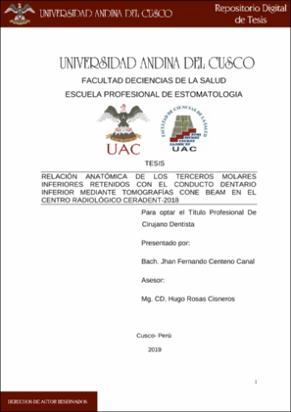| dc.contributor.advisor | Rosas Cisneros, Hugo Leoncio | |
| dc.contributor.author | Centeno Canal, Jhan Fernando | |
| dc.date.accessioned | 2019-10-30T15:20:27Z | |
| dc.date.available | 2019-10-30T15:20:27Z | |
| dc.date.issued | 2019-08-28 | |
| dc.identifier.uri | https://hdl.handle.net/20.500.12557/2954 | |
| dc.description.abstract | El estudio tiene un diseño no experimental de tipo descriptivo observacional,
transversal longitudinal cuyo planteamiento del problema menciona que los
estudios realizados en la India, Grecia y en La Abana-Cuba revelan que las
complicaciones neurosensoriales a la extracción de los terceros molares inferiores
retenidos son de 4%, 3,6% 3,5%, por ello esta tesis tiene como objetivo
determinar la relación anatómica del tercer molar inferior retenido con el conducto
dentario inferior mediante tomografías cone beam en el centro radiológico
ceradent-2018, estuvo constituida por 152 tomografías cone beam y una muestra
de 21 tomografías, siendo 10 del sexo masculino y 11 del sexo femenino. Se
determinaron los siguientes resultados: que la posición relativa del conducto
dentario inferior con los terceros molares inferiores retenidos, la más prevalente
fue la posición lingual con un 34.6%; en la frecuencia de contacto de los terceros
molares inferiores retenidos con el conducto dentario inferior, el no contacto se
encuentra con mayor frecuencia con un 57.7%; y que la distancia más cercana de
los terceros molares inferiores retenidos con el conducto dentario inferior, es el
grupo de 2 a 3 mm que está en un 15.4% | es_PE |
| dc.description.abstract | The study has a non-experimental design of an observational, longitudinal
transversal descriptive type whose approach of the problem mentions that the
studies carried out in India, Greece and La Abana-Cuba reveal that the
neurosensory complications to the extraction of the retained lower third molars are
of 4%, 3.6% 3.5%, so this thesis aims to determine the anatomical relationship of
the lower third molar retained with the lower dental canal through cone beam
tomography at the ceradent-2018 radiological center, consisted of 152 tomographs
cone beam and a sample of 21 tomographs, 10 being male and 11 female. The
following results were determined: that the relative position of the lower dental
canal with the retained lower third molars, the most prevalent was the lingual
position with 34.6%; in the frequency of contact of the lower third molars retained
with the lower dental canal, non-contact is more frequently found with 57.7%; and
that the closest distance of the lower third molars retained with the lower dental
canal is the group of 2 to 3 mm that is 15.4% | en_US |
| dc.description.uri | Tesis | es_PE |
| dc.format | application/pdf | es_PE |
| dc.language.iso | spa | es_PE |
| dc.publisher | Universidad Andina del Cusco | es_PE |
| dc.rights | info:eu-repo/semantics/openAccess | es_PE |
| dc.rights.uri | https://creativecommons.org/licenses/by-nc-nd/2.5/pe/ | es_PE |
| dc.source | Universidad Andina del Cusco | es_PE |
| dc.source | Repositorio Institucional - UAC | es_PE |
| dc.subject | Anatomía dental | es_PE |
| dc.subject | Tomografía | es_PE |
| dc.title | Relación anatómica de los terceros molares inferiores retenidos con el conducto dentario inferior mediante tomografías Cone Beam en el Centro Radiológico Ceradent-2018 | es_PE |
| dc.type | info:eu-repo/semantics/bachelorThesis | es_PE |
| thesis.degree.name | Cirujano dentista | es_PE |
| thesis.degree.grantor | Universidad Andina del Cusco. Facultad de Ciencias de la Salud | es_PE |
| thesis.degree.level | Titulo Profesional | es_PE |
| thesis.degree.discipline | Estomatología | es_PE |


